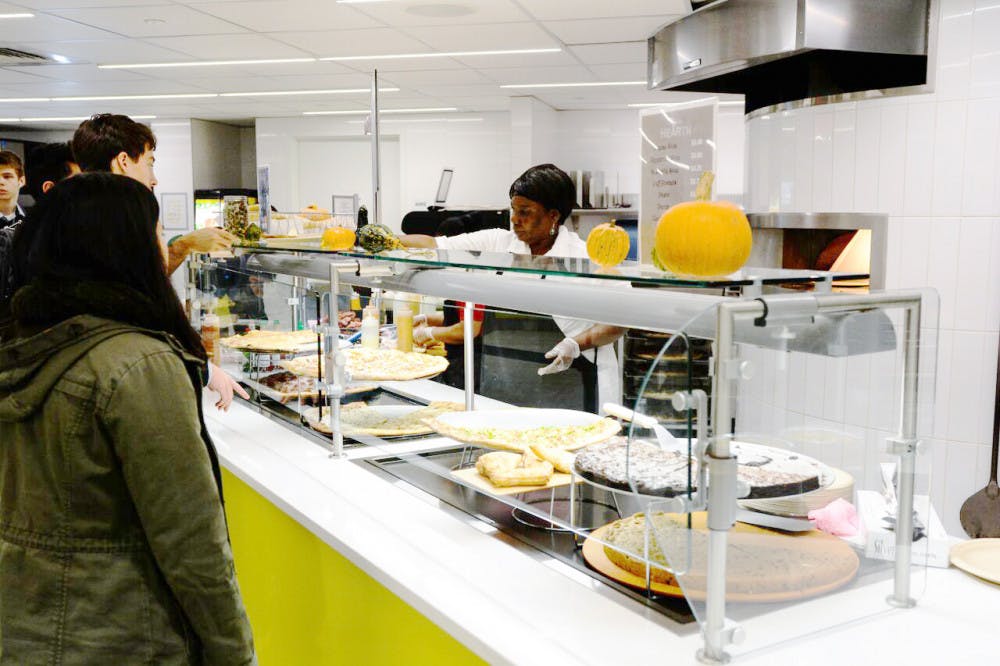Three pieces of breaded chicken from the Verney-Woolley Dining Hall on Chicken Finger Friday packs in 430 calories, according to the Brown Dining Services’ nutrition website. One serving of vegetarian spinach strudel — an entree at the Sharpe Refectory on Thursday — contains 519 calories and 96 percent of the recommended daily intake of saturated fat.
“At Andrews Commons now during the weekends, they serve donuts, bacon and glazed toppings. It’s like they want us to get diabetes,” said Claire Detrick-Jules ’17. “Sometimes it’s tough to make healthy choices because the desserts and sweets look so much more appetizing than the healthy food,” she added.
During the week, Andrews offers variations of pizza, paninis and Asian fusion cuisine as well as cookie pie and brownies. Josiah’s, the University’s late-night eatery, offers fries, fried chicken sandwiches, quesadillas, mozzarella sticks, cheeseburgers, cookies and a chopped salad bar.
The college lifestyle is infamous for packing on the pounds, and Tracy Bergeron, nutritionist at Health Services, wrote in an email to The Herald that she does not think Brown is exempt from this trend.
“I don’t think it’s necessarily easy to make healthy eating choices in general, so Brown would be no exception,” Bergeron wrote.
Decisions related to nutrition “take forethought and planning, in part of what is likely an already busy day. With that said, I do believe there are a variety of healthy eating choices available on campus,” she wrote.
Menus are designed to offer students minimally processed carbohydrates, healthful fats and plant-based proteins, wrote Jessie Curran, dietician for Dining Services, in an email to The Herald.
Curran, the University’s culinary team, the purchasing team and Dining Services administrators formulate the menu offered in the Ratty and V-Dub.
The group examines each week’s menus one month prior to their appearance in the dining halls. Decisions are made based on nutrition, sustainability, aesthetic quality of meals and plate cost, Curran wrote.
In addition to these guidelines, menus at the main dining halls always offer one vegetarian and one vegan entree, two meat entrees and three vegetable sides.
But multiple students said they would appreciate a wider variety of healthy options, such as nuts and more fresh fruit and vegetables.
“You can make healthy eating choices if you plan it right, but I think you do have to choose what eatery you want to go to — Andrews Commons definitely has less healthy options,” said Naima Msechu ’17.
Students today seem more conscientious than ever about eating a healthful diet, Curran wrote. “We’ve made changes this year to reflect that by increasing vegetable options, increasing use of ancient grains and expanding the salad bar options,” she wrote.
Dining Services aims to serve locally grown foods in part because produce that spends little time in storage undergoes less “nutrient degradation,” wrote Assistant Chef Aaron Fitzenry in an email to The Herald.
Thirty-five percent of the University’s food is sourced locally, Curran wrote, and Dining Services works with more than 50 local farms and farmers to supply ingredients for residential dining.
For example, the University purchases its beef from Niman Ranch, a distributor of “all-natural meats raised by small family farmers,” according to its website. Cattle from Niman Ranch are fed a 100 percent vegetarian diet and do not receive hormone or antibiotic treatments, Curran wrote.
The University was ranked 19th on the food website the Daily Meal’s “75 Best Colleges for Food in America” list in 2015, placing Brown above several other Ivy League institutions, including Yale (21st), Harvard (24th) and Princeton (44th). The ranking reflects efforts in nutrition, sustainability, accessibility, service and education.
Despite the high ranking, students expressed mixed reactions on the quality of food served on campus.
“I feel like the food is tasteless, and although there is a wide range of choice in the Ratty, I’m never able to find anything I actually want to eat,” said Emily Haynes-Simmons ’18. “And the chicken is always overcooked.”
“The Ratty has a lot of variety, but it’s poor quality food,” said Jessica Simon ’18. “I want them to actually care about what they’re serving us.”
Other students had very few complaints. “I think it’s pretty good in terms of quality, but it’s a little bit expensive,” said Tomoki Ishizuka ’19.
Some improvements students want to see include healthier options at Andrews Commons, more seafood and a wider variety of breakfast cereals.





